June 27th: Vegetation Week 4
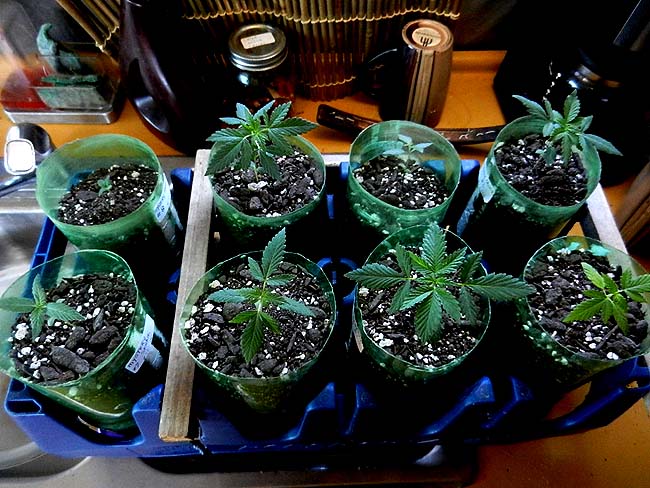
All plants making normal progress.
6-28: The youngest seedling, #8, did not survive a fall off the shelf
6-29: All seedlings were given another 1/4 cup
of plain water bringing the containers to 650 grams.
July 4th: Vegetation Week 5
All plants doing well having put on another inch this past week. In two weeks
when the last of Grow # 12 is harvested these plants will be moved to the
flowering chamber along with Grows 13 and 14. The photoperiod will be reset
to 18/6 so that they can all continue to vegetate. The intent is to grow
them to 12" or so before forcing them into flower in order to determine their
sex and discard the males.
7-5: All plants were given 1/2 cup RO H
2O with a heavy (2 tbls p/gal) feeding of BioThrive Grow bringing the individual container's weight to 650 grams.
July 11th: Vegetation Week 6
The plants have put on good growth this last week and now range in height
from 3 inches to 5 inches. The shorter plants spend their days in the flowering
chamber under the more powerful LED light in order to catch up to the other
four.
All plants were given 1/2 cup RO H
2O with a heavy (2 tbls p/gal) feeding of BioThrive Grow bringing the individual container's weight to 650 grams.
7-17:
All plants were given 1/2 cup RO H
2O with a heavy (2 tbls p/gal) feeding of BioThrive Grow bringing the individual container's weight to 600 grams.
July 18th: Vegetation Week 7
I just realized that I do not need to maintain two separate chambers ...
the LED lit chamber can be left on an 18/6 photoperiod and those plants that
are ready to flower just need to be removed at 6 pm to a dark chamber until
morning to meet the required 12 hours of darkness that flowering plants need
each day.
This allows the not quite ready plants to continue their vegetation
under the best light. Seedling and clones can still be started under fluorescents
in the former vegetation chamber until they are ready to be transferred.
Now that Grow 12 has been harvested the photoperiod in the flowering chamber
was reset to 18/6 and all of the remaining plants transferred over to continue
their vegetation.
7-21:
All plants were given 1/2 cup RO H
2O with a heavy (2 tbls p/gal) feeding of BioThrive Grow bringing the individual container's weight to 600 grams.
7-24:
All plants were given 1/2 cup RO H
2O with a heavy (2 tbls p/gal) feeding of BioThrive Grow bringing the individual container's weight to 600 grams.
July 25th: Vegetation Week 8
Plants putting on good growth.
7-27:
All plants were given 1/2 cup RO H
2O with a heavy (2 tbls p/gal) feeding of BioThrive Grow bringing the individual container's weight to 600 grams.
7-31:
All plants were given 1/2 cup RO H
2O with a heavy (2 tbls p/gal) feeding of BioThrive Grow bringing the individual container's weight to 600 grams.
August 1st: Vegetation Week 9

All 7 plants topped to encourage bushier growth.
It will take them about two weeks to completely recover and regain the lost
height. The plants are arranged in the middle and lower right in the photograph.
Noticeably one of them is significantly lighter in color. I thought
at first it might be a nitrogen deficiency but the plant has received exactly
the same nutrients as the others. I am beginning to think it just has a different
metabolism as it appears to have suffered no impediment to growth.
8-3: All plants were given 1/2 cup plain H
2O bringing the individual container's weight to 600 grams.
8-7: All plants were given 1 cup RO H
2O with a heavy (2 tbls p/gal) feeding of BioThrive Grow bringing the individual container's weight to 600 grams.
August 8th: Vegetation Week 10
All plants making normal progress.
8-10: All plants were given 1.5 cups RO H
2O with a heavy (2 tbls p/gal) feeding of BioThrive Bloom bringing the individual container's weight to 650 grams.
8-13: All plants were given 1.5 cups RO H
2O with a heavy (2 tbls p/gal) feeding of BioThrive Grow bringing the individual container's weight to 650 grams.
August 15th: Flowering Week 1
Given the rapid growth and increasing height of these plants they were switched
to the flowering mode this weekend after a 24 hour period of total darkness.
Within 6-10 days it will be possible to determine their eventual sex and
all the males will be discarded to prevent fertilization of the remaining
females in the flowering chamber.
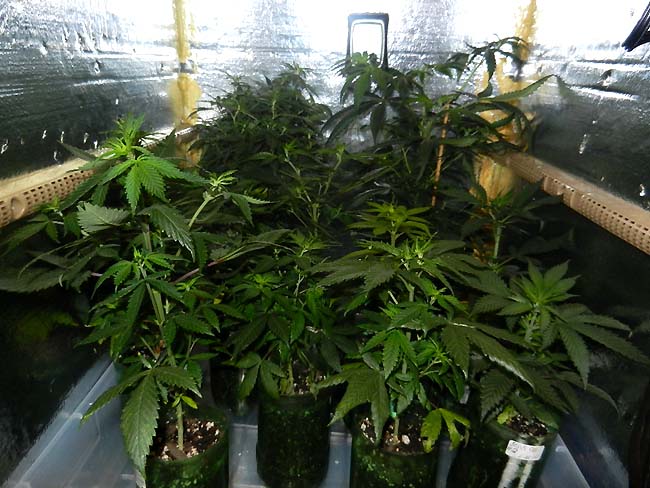
In this image you can see the actual height of the canopy ... most of the
plants are near or in excess of 10 inches and will increase another 2-4 in
the first month of flowering. After sexing the remaining females will be transplanted
to 1 gallon nursery pots.
Once all of the plants have been transplanted a wire grid will be lowered
down over the tops resting on the side rails shown above. This will limit
further vertical growth forcing the plants to expand sideways under the grid.
8-13: All plants were given 1.5 cups RO H
2O with a heavy (2 tbls p/gal) feeding of BioThrive Grow bringing the individual container's weight to 650 grams.
Four of the plants have been sexed as female: #'s 1, 2, 4, 5. They will be
transplanted to the larger 1 gallon nursery pots this week. Interestingly
these were the four tallest of the seven plants though I had read that the
males were always taller. The other 3 plants will be sexed in the coming
week but I am pretty sure they will be male ... they are of similar size
and shorter than the identified females. I remember being surprised
by the tall females in previous grows and this pretty much refutes that earlier
understanding.
8-18: Transplanted clearly identified females #s
3, 4, and 5 to one gallon pots and brought the average wet weight to 1450 grams. Number 1 and 2 are not yet putting out pistils
although I thought I saw some on the 13th. The other two (6 and 7) look to
be developing pollen sacks although they might be hermaphrodite and so they
have been isolated in the other chamber to prevent accidental pollination.
8-19: The four plants in the 1.5 liter bottles were given 1.5 cups RO H
2O with a heavy (2 tbls p/gal) feeding of BioThrive Grow bringing the individual container's weight to 650 grams.
8-21: All the plants in this grow are now being watered in
place underneath the grid so all were given just 1 cup of plain RO H
2O prevent excessive dripping into the saucers.
August 22nd: Flowering Week 2

Plants #s 1, 2 and 6 revealed themselves as female and were immediately
transplanted into a 1 gallon nursery pots filled with Happy Frog organic potting
soil. Since the plants had been recently watered only enough water was added
to bring the wet weight to 1450 grams. Plant #7 also came out - as a male so it was discarded.
Remarkably 6 out of the 7 plants were female - the normal ratio is 50/50.
I'm still keeping an eye on them to make sure they are not hermaphrodites.
The plants cover the front half of the grid and the two larger plants (Mystery
Plant mother on the left, Pineapple Express on the right) will fill in the
rear half.
8-24: All plants were given 1.5 cups RO H
2O with a heavy (2 tbls p/gal) feeding of BioThrive Bloom. They should be watered every three days now for consistent growth.
8-27: All plants were given 1 cup of RO H
2O with a heavy (2 tbls p/gal) feeding
of BioThrive Bloom.
August 29th: Flowering Week 3
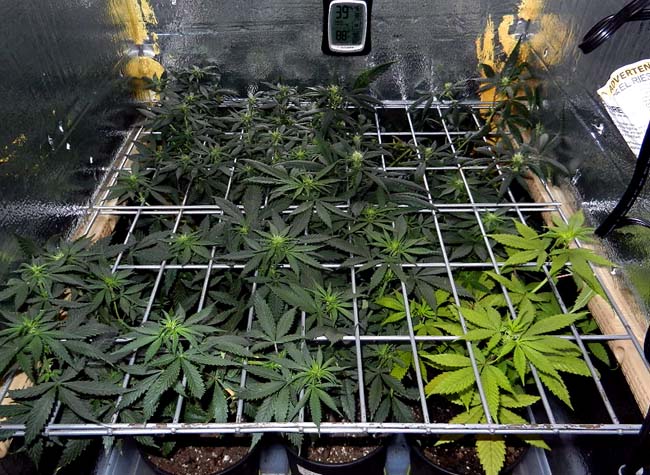
Not a lot of change but most of the flowers above the screen on these plants (front half of screen)
are beginning to show multiple pistils. As the plants elongate under the
screen the flowers are repositioned to fill every opening.
8-30:
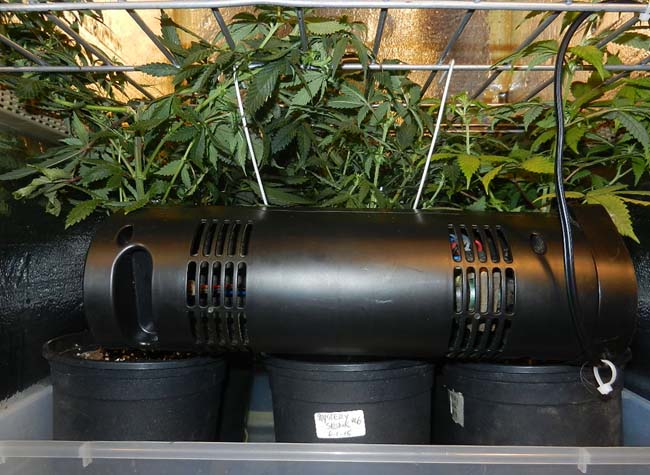
Comparing this grow to the others I seem
to notice a lack of vigor and smaller leaf sizes. The only change is that
I had removed a 14" oscillating fan because I felt it was too desiccating.
But with it gone the chamber felt sultry as if it were not getting enough
fresh air.
Today I reinstalled the fan but instead of a vertical mount I suspended it
horizontally from the grid so that it was positioned to provide a gentle
breeze down the center beneath the canopy. Since its twin intakes are at the front
of the chamber by the door it was expected to help improve the overall circulation.
That improvement was confirmed by blowing smoke into
the chamber through the slightly propped open door.
Due to the high temperatures and continuing drought ants, in search of water,
are venturing indoors. Apparently some time ago when the plants were still
being watered in the sink the bottoms of the pots picked up a number of ants
while draining on the counter. Rather than introduce ant spray into the all
organic chamber I have been picking them off one by one as they appear. This
morning I removed another one after not seeing any for a couple of days.
So far that makes a total of eight.
The plants were given 1 cup of RO H
2O with a heavy (2 tbls p/gal) feeding
of BioThrive Bloom.
9-1: The plants were given 1 cup of RO H
2O with a heavy (2 tbls p/gal) feeding
of BioThrive Bloom one day early as I will be out of town tomorrow leaving before sunup.
9-4: The plants were given 1 cup of RO H
2O with a heavy (2 tbls p/gal) feeding
of BioThrive Bloom. Additional organic potting soil was added to top off the container.
Week 4
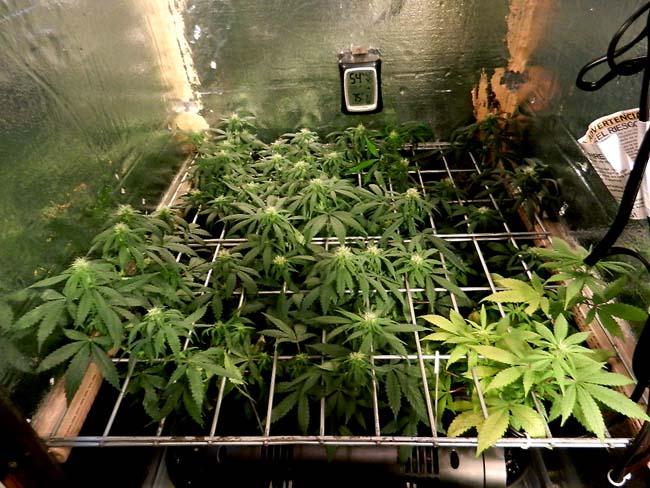
The grid continues to fill with flowers albeit somewhat unevenly given the
different heights of the plants when flowering was initiated. The taller
plants were topped which doubled the number of their flowers.
9-7: The plants were given 1 cup of RO H
2O.
9-10: The plants were given 1.5 cups of RO H
2O with a heavy (2 tbls p/gal) feeding
of BioThrive Bloom.
September 12th: Flowering Week 5
Week 5 and everything is progressing normally with another full month to go.
9-13: The plants were given 1 cup of plain RO H
2O.
9-16: The plants were given 1.5 cups of RO H
2O with a heavy (2 tbls p/gal) feeding
of BioThrive Bloom.
September 19th: Flowering Week 6
The
plants are continuing to develop normally with 15 main colas (terminals)
between the six plants and twice as many smaller side buds. In the next 3-4
weeks they should easily double in weight. It is too early to fairly estimate
but between 1 - 2 ounces dried.
The plants were given 1.5 cups of RO H
2O with a heavy (2 tbls p/gal) feeding
of BioThrive Bloom.
9-21: The plants were given 1 cup of plain RO H
2O.
9-23:
The plants were given 1 cup of RO H
2O with a heavy (2 tbls p/gal) feeding
of BioThrive Bloom.
9-25: The plants were given 1 cup of RO H
2O with a heavy (2 tbls p/gal) feeding
of BioThrive Bloom.
September 26th: Flowering Week 7
The flowers are noticeably increasing
in girth and length and becoming quite sticky and smelly at times. Last night
I inadvertently shut down several of the exhaust and ventilation fans resulting
in the coach being filled with a skunky sweet smell.
9-27: The plants were given 1 cup of RO H
2O with a heavy (2 tbls p/gal) feeding
of BioThrive Bloom.
9-30: The plants were given 1 cup of RO H
2O with a heavy (2 tbls p/gal) feeding
of BioThrive Bloom.
10-2: The plants were given 1 cup of RO H
2O with a heavy (2 tbls p/gal) feeding
of BioThrive Bloom.
October 3rd:
Flowering Week 8
Since
the plants are now just two weeks away from harvest they will no longer be
fed any fertilizers and will receive only plain water. My experience
is that there is a noticeable difference in taste and smoothness when fertilizers
are withheld.
10-6: The plants were given 1.5 cups of RO H
2O.
10-8: The plants were given 1.5 cups of RO H
2O. Temperatures over 80F all week.
October 10th: Flowering Week 9

Both sets of plants (6 Mystery Skunk and 1 Mystery mother plant from Grow
12) had their canopies rearranged with the flowers moved more towards
the center of the light cone for maximum exposure during these last weeks
prior to harvest.
10-11: The plants were given 1.5 cups of RO H
2O.
8 Grams of the smaller secondary buds (Day 58) were harvested today
and set aside in a small clamp top bottle as a test of a combined drying
and curing process.
Harvest Log
Mystery Skunk
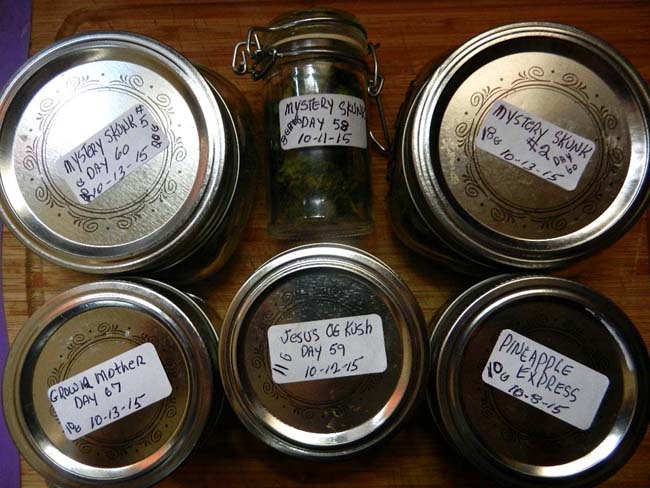
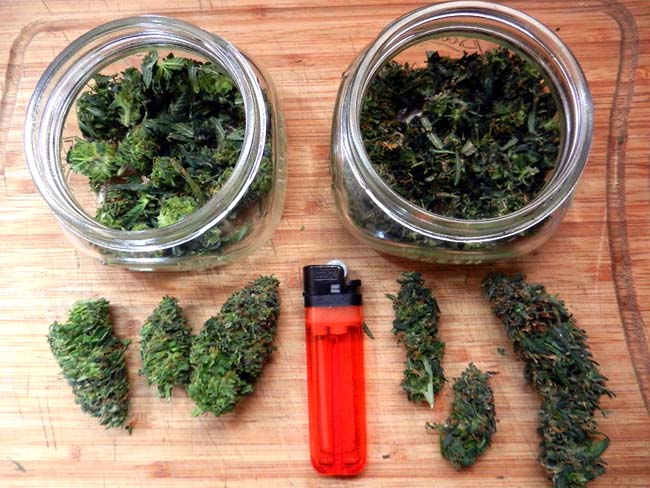 Drying Schedule
Drying Schedule
DATE
|
Day
|
Description
|
Dry
|
10-15
|
58
|
Small buds - all plants
|
13 grams
|
10-15
|
62
|
Large buds - all plants
|
14 grams
|
10-13
|
60
|
Plant #2 & 4
|
5 grams
|
10-13
|
67
|
Grow #12 Mother plant *
|
3 grams
|
10-19
|
|
Total:
|
35 grams
|
|
|
Trim - Sugar (single lobe) leaf
|
16 grams
|
|
|
Trim - Shake (multi lobed) leaf
|
60 grams
|
10-19
|
|
Total:
|
76 grams
|
* Only 1/3 of the buds harvested ... the remainder will be allowed to grow for another week or so.
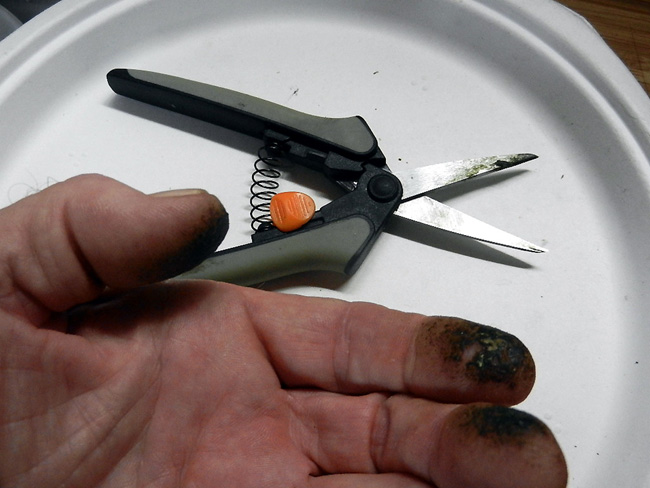
After all the trimming this morning my fingers were covered in resin - referred
to by professional trimmers as finger hash because it can be peeled off and
smoked. The best trimmers can manicure upwards of 1 pound of trimmed
buds per day and can accumulate several grams of finger hash which is theirs
to keep.
All of these buds will be jar dried over the next 30 days.
The jars will need to be ventilated several times a day for the next 10 days
until the excess moisture is evaporated. Some may have to be transferred
to paper bags if they don't dry fast enough ... plant #2 is currently in
a paper bag because it was starting to smell moldy. After that they will
be stabilized but will continue to age and cure.

This is 16 grams of sugar leaf ... the single bladed leaves surrounding the
flower's calyx (ovary) ... not as potent as the bud itself but excellent
for making tea. One tablespoon is slightly roasted to crisp and transferred
to a water bath (double boiler) along with two tablespoons butter to simmer
for 20 minutes. Strained and added to green tea ...another way to start the
morning
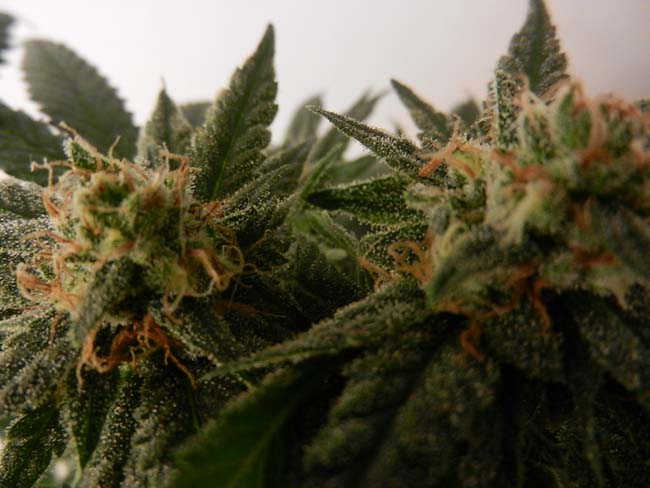
Here is a close up ... you can see why they are called sugar leaves - sprinkled
with trichomes or resin glands that glitter like ... sugar.
Finally we have 60 grams of dried shake - the multi-lobed fan leaves separated
from stem and stored in this large stoppered jar. These leaves contain enough
resin glands to be useful in cooking but not enough for other purposes.